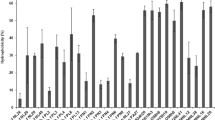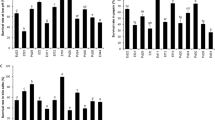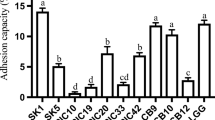Abstract
Probiotics are beneficial microorganisms, mostly lactic acid bacteria (LAB), that offer health benefits to the host when consumed in adequate amounts. This study assessed the probiotic efficacy and safety of LAB strains isolated from Laban, a traditional fermented milk product. Seven primarily selected Gram-positive, catalase-negative, non-spore-forming isolates were examined for their antimicrobial activity against the bacterial pathogens Bacillus cereus, Salmonella typhi, Staphylococcus aureus, and Vibrio cholera, and the fungal pathogen Candida albicans. Two isolates, identified as Pediococcus pentosaceus L1 and Streptococcus thermophilus L3, which showed antimicrobial activity against all pathogens, were further evaluated for their probiotic competence. The selected isolates demonstrated strong resistance to low pH, bile salts, and phenol, indicating their potential for gastric endurance. They also exhibited high cell surface hydrophobicity to various hydrocarbons, autoaggregation, and coaggregation properties, demonstrating strong adhesion abilities. In addition, both isolates showed strong antioxidant activity and were non-hemolytic. Although the isolates had some resistance to certain antibiotics, they were generally susceptible to commonly used antibiotics. The two LAB strains also exhibited promising technological properties, such as milk coagulation and exopolysaccharide production, indicating their potential to enhance the quality of dairy products. The results suggest that the LAB strains isolated from Laban have strong potential as probiotics, and due to their food origin, they are highly likely to exhibit maximal efficacy in food and pharmaceutical products for human consumption.


Similar content being viewed by others
Data availability
All data relevant to the study and the accession numbers are available in the article.
References
Akinyemi MO, Ogunremi OR, Adeleke RA, Ezekiel CN (2022) Probiotic potentials of lactic acid bacteria and yeasts from raw goat milk in Nigeria. Probiotics Antimicrob Proteins 15:1–18
Akmal U, Ghori I, Elasbali AM, Alharbi B, Farid A, Alamri AS, Muzammal M, Asdaq SMB, Naiel MA, Ghazanfar S (2022) Probiotic and antioxidant potential of the Lactobacillus spp. isolated from artisanal fermented pickles. Fermentation 8:328
Akpinar A, Yerlikaya O, Kiliç S (2011) Antimicrobial activity and antibiotic resistance of Lactobacillus delbrueckii ssp. bulgaricus and Streptococcus thermophilus strains isolated from Turkish homemade yoghurts. Afr J Microbiol Res 5:675–682
Ali F, Das S, Hossain TJ, Chowdhury SI, Zedny SA, Das T, Chowdhury MNA, Uddin MS (2021) Production optimization, stability and oil emulsifying potential of biosurfactants from selected bacteria isolated from oil-contaminated sites. R Soc Open Sci 8:211003
Ammor MS, Flórez AB, van Hoek AHAM, de los Reyes-Gavilán CG, Aarts HJM, Margolles A, Mayo B (2008) Molecular characterization of intrinsic and acquired antibiotic resistance in lactic acid bacteria and bifidobacteria. Microb Physiol 14:6–15
Armas F, Camperio C, Marianelli C (2017) In vitro assessment of the probiotic potential of Lactococcus lactis LMG 7930 against ruminant mastitis-causing pathogens. PLoS ONE 12:e0169543
Ayyash MM, Abdalla AK, AlKalbani NS, Baig MA, Turner MS, Liu S-Q, Shah NP (2021) Invited review: characterization of new probiotics from dairy and nondairy products—insights into acid tolerance, bile metabolism and tolerance, and adhesion capability. J Dairy Sci 104:8363–8379
Bintsis T (2017) Foodborne pathogens. AIMS Microbiol 3:529
Chammas IG, Saliba R, Béal C (2006) Characterization of the fermented milk “Laban” with sensory analysis and instrumental measurements. J Food Sci 71:S156–S162
Chen T, Wang L, Li Q, Long Y, Lin Y, Yin J, Zeng Y, Huang L, Yao T, Abbasi MN, Yang H, Wang Q, Tang C, Khan TA, Liu Q, Yin J, Tu Q, Yin Y (2020) Functional probiotics of lactic acid bacteria from Hu sheep milk. BMC Microbiol 20:228
Chowdhury MNA, Hossain TJ, Zedny SA, Islam S, Rahman M, Islam R, Nafiz IH (2023) Multifaceted plant growth promoting traits and abiotic stress resistance abilities exhibited by chrysanthemum rhizobacteria. Preprint Available at SSRN: https://ssrn.com/abstract=4306331
Chowdhury T, Ferdouse J (2012) Isolation, characterization and antimicrobial activity of lactic acid bacteria from local milk and milk products. Bangladesh J Microbiol 29:76–82
Coelho MC, Malcata FX, Silva CC (2022) Lactic acid bacteria in raw-milk cheeses: from starter cultures to probiotic functions. Foods 11:2276
Evivie SE, Huo G-C, Igene JO, Bian X (2017) Some current applications, limitations and future perspectives of lactic acid bacteria as probiotics. Food Nutr Res 61:1318034
Feng T, Wang J (2020) Oxidative stress tolerance and antioxidant capacity of lactic acid bacteria as probiotic: a systematic review. Gut Microbes 12:1801944
Ferdouse J, Paul S, Chowdhury T, Ali F, Islam S, Hossain TJ (2023) Probiotic characteristics of Pediococcus pentosaceus and Apilactobacillus kunkeei strains: the lactic acid bacteria isolated from Bangladeshi natural honey. Appl Food Biotechnol 10:33–45
Fidan H, Esatbeyoglu T, Simat V, Trif M, Tabanelli G, Kostka T, Montanari C, Ibrahim SA, Özogul F (2022) Recent developments of lactic acid bacteria and their metabolites on foodborne pathogens and spoilage bacteria: facts and gaps. Food Biosci 47:101741
Gao Z, Daliri EB-M, Wang JUN, Liu D, Chen S, Ye X, Ding T (2019) Inhibitory effect of lactic acid bacteria on foodborne pathogens: a review. J Food Prot 82:441–453
Garcia EF, Luciano WA, Xavier DE, da Costa WC, de Sousa Oliveira K, Franco OL, de Morais Junior MA, Lucena BT, Picao RC, Magnani M (2016) Identification of lactic acid bacteria in fruit pulp processing byproducts and potential probiotic properties of selected Lactobacillus strains. Front Microbiol 7:1371
Ghanbari M, Jami M, Domig KJ, Kneifel W (2013) Seafood biopreservation by lactic acid bacteria—a review. LWT-Food Sci Technol 54:315–324
Guleria S, Walia A, Chauhan A, Shirkot CK (2016) Optimization of milk-clotting enzyme production by Bacillus amyloliquefaciens SP1 isolated from apple rhizosphere. Bioresour Bioprocess 3:1–9
Hossain TJ, Alam M, Sikdar D (2011) Chemical and microbiological quality assessment of raw and processed liquid market milks of Bangladesh. Cont J Food Sci Technol 5:6–17
Hossain TJ, Chowdhury SI, Mozumder HA, Chowdhury MNA, Ali F, Rahman N, Dey S (2020) Hydrolytic exoenzymes produced by bacteria isolated and identified from the gastrointestinal tract of Bombay duck. Front Microbiol 11:2097
Hossain TJ (2022) Functional genomics of the lactic acid bacterium Limosilactobacillus fermentum LAB-1: metabolic, probiotic and biotechnological perspectives. Heliyon 8:e11412
Hossain TJ (2023) Methods for screening and evaluation of antimicrobial activity: a review of protocols, advantages and limitations. Preprint Available at SSRN: https://ssrn.com/abstract=4512752
Indira M, Venkateswarulu TC, Abraham Peele K, Nazneen Bobby Md, Krupanidhi S (2019) Bioactive molecules of probiotic bacteria and their mechanism of action: a review. 3 Biotech 9:306
Kandylis P, Pissaridi K, Bekatorou A, Kanellaki M, Koutinas AA (2016) Dairy and non-dairy probiotic beverages. Curr Opin Food Sci 7:58–63
Kang C-H, Kim J-S, Park HM, Kim S, Paek N-S (2021) Antioxidant activity and short-chain fatty acid production of lactic acid bacteria isolated from Korean individuals and fermented foods. 3 Biotech 11:217
Khaneghah AM, Abhari K, Eş I, Soares MB, Oliveira RB, Hosseini H, Rezaei M, Balthazar CF, Silva R, Cruz AG (2020) Interactions between probiotics and pathogenic microorganisms in hosts and foods: a review. Trends Food Sci Technol 95:205–218
Klayraung S, Okonogi S (2009) Antibacterial and antioxidant activities of acid and bile resistant strains of Lactobacillus fermentum isolated from Miang. Braz J Microbiol 40:757
Ladha G, Jeevaratnam K (2020) Characterization of purified antimicrobial peptide produced by Pediococcus pentosaceus LJR1, and its application in preservation of white leg shrimp. World J Microbiol Biotechnol 36:72
Lepecka A, Szymański P, Okoń A, Zielińska D (2023) Antioxidant activity of environmental lactic acid bacteria strains isolated from organic raw fermented meat products. LWT 174:114440
Li M, Wang Y, Cui H, Li Y, Sun Y, Qiu H-J (2020) Characterization of lactic acid bacteria isolated from the gastrointestinal tract of a wild boar as potential probiotics. Front Vet Sci 7:49
Mahjoory Y, Mohammadi R, Hejazi MA, Nami Y (2023) Antifungal activity of potential probiotic Limosilactobacillus fermentum strains and their role against toxigenic aflatoxin-producing aspergilli. Sci Rep 13:388
Marco ML, Heeney D, Binda S, Cifelli CJ, Cotter PD, Foligné B, Gänzle M, Kort R, Pasin G, Pihlanto A (2017) Health benefits of fermented foods: microbiota and beyond. Curr Opin Biotechnol 44:94–102
Moh LG, Etienne PT, Jules-Roger K (2021) Seasonal diversity of lactic acid bacteria in Artisanal Yoghurt and their antibiotic susceptibility pattern. Int J Food Sci 2021:e6674644
Monteagudo-Mera A, Rodríguez-Aparicio L, Rúa J, Martínez-Blanco H, Navasa N, García-Armesto MR, Ferrero MÁ (2012) In vitro evaluation of physiological probiotic properties of different lactic acid bacteria strains of dairy and human origin. J Funct Foods 4:531–541
Moračanin SV, Djukić D, Zdolec N, Milijašević M, Mašković P (2017) Antimicrobial resistance of lactic acid bacteria in fermented food. J Hyg Eng Des 18:25–35
Ng SY, Koon SS, Padam BS, Chye FY (2015) Evaluation of probiotic potential of lactic acid bacteria isolated from traditional Malaysian fermented Bambangan (Mangifera pajang). CyTA J Food 13:563–572
Nigatu JM, Tuji FA, Tefera AT (2015) Evaluation of the antagonistic effect of six mixed cultures of lactic acid bacteria, isolated from the Ethiopian fermented milk ergo, against some foodborne pathogens inoculated into the Ethiopian cottage cheese ayib. Afr J Microbiol Res 9(29):1789–1797
Pasolli E, De Filippis F, Mauriello IE, Cumbo F, Walsh AM, Leech J, Cotter PD, Segata N, Ercolini D (2020) Large-scale genome-wide analysis links lactic acid bacteria from food with the gut microbiome. Nat Commun 11:2610
Prabhurajeshwar C, Chandrakanth RK (2017) Probiotic potential of Lactobacilli with antagonistic activity against pathogenic strains: an in vitro validation for the production of inhibitory substances. Biomed J 40:270–283
Reis JA, Paula AT, Casarotti SN, Penna ALB (2012) Lactic acid bacteria antimicrobial compounds: characteristics and applications. Food Eng Rev 4:124–140
Rokana N, Singh BP, Thakur N, Sharma C, Gulhane RD, Panwar H (2018) Screening of cell surface properties of potential probiotic Lactobacilli isolated from human milk. J Dairy Res 85:347–354
Rühmann B, Schmid J, Sieber V (2015) Methods to identify the unexplored diversity of microbial exopolysaccharides. Front Microbiol 6:565
Saad N, Delattre C, Urdaci M, Schmitter J-M, Bressollier P (2013) An overview of the last advances in probiotic and prebiotic field. LWT-Food Sci Technol 50:1–16
Sadeghi M, Panahi B, Mazlumi A, Hejazi MA, Komi DEA, Nami Y (2022) Screening of potential probiotic lactic acid bacteria with antimicrobial properties and selection of superior bacteria for application as biocontrol using machine learning models. LWT 162:113471
Shahverdi S, Barzegari AA, Vaseghi Bakhshayesh R, Nami Y (2023) In-vitro and in-vivo antibacterial activity of potential probiotic Lactobacillus paracasei against Staphylococcus aureus and Escherichia coli. Heliyon 9:e14641
Šušković J, Kos B, Beganović J, Leboš Pavunc A, Habjanič K, Matošić S (2010) Antimicrobial activity–the most important property of probiotic and starter lactic acid bacteria. Food Technol Biotechnol 48:296–307
Syngai GG, Gopi R, Bharali R, Dey S, Lakshmanan GMA, Ahmed G (2016) Probiotics—the versatile functional food ingredients. J Food Sci Technol 53:921–933
Tarannum N, Ali F, Khan MS, Alhumaidan OS, Zawad ANMS, Hossain TJ (2023) Bioactive exopolysaccharide from Limosilactobacillus fermentum LAB-1: antioxidant, anti-inflammatory, antibacterial and antibiofilm properties. Preprint Available at SSRN: https://ssrn.com/abstract=4573628
Tegegne BA, Kebede B (2022) Probiotics, their prophylactic and therapeutic applications in human health development: A review of the literature. Heliyon 8:e09725
Terpou A, Papadaki A, Lappa IK, Kachrimanidou V, Bosnea LA, Kopsahelis N (2019) Probiotics in food systems: significance and emerging strategies towards improved viability and delivery of enhanced beneficial value. Nutrients 11:1591
Topçu KC, Kaya M, Kaban G (2020) Probiotic properties of lactic acid bacteria strains isolated from pastırma. LWT 134:110216
Unban K, Chaichana W, Baipong S, Abdullahi AD, Kanpiengjai A, Shetty K, Khanongnuch C (2021) Probiotic and antioxidant properties of lactic acid bacteria isolated from indigenous fermented tea leaves (Miang) of north thailand and promising application in synbiotic formulation. Fermentation 7:195
Werning ML, Hernández-Alcántara AM, Ruiz MJ, Soto LP, Dueñas MT, López P, Frizzo LS (2022) Biological functions of exopolysaccharides from lactic acid bacteria and their potential benefits for humans and farmed animals. Foods 11:1284
Yadav R, Puniya AK, Shukla P (2016) Probiotic properties of Lactobacillus plantarum RYPR1 from an indigenous fermented beverage raabadi. Front Microbiol 7:1683
Zobaer, M., Ali, F., Anwar, M.N., Bappi, M.S.H., Bakar, T.B. & Hossain, T.J. (2023). Isolation of Biosurfactant Producing Bacteria from Oil-Spilled Soil and Characterization of Their Secreted Biosurfactants in Pathogen-Inhibition and Oil-Emulsification.
Zommiti M, Connil N, Hamida JB, Ferchichi M (2017) Probiotic characteristics of Lactobacillus curvatus DN317, a strain isolated from chicken ceca. Probiotics Antimicrob Proteins 9:415–424
Zommiti M, Cambronel M, Maillot O, Barreau M, Sebei K, Feuilloley M, Ferchichi M, Connil N (2018) Evaluation of probiotic properties and safety of Enterococcus faecium isolated from artisanal tunisian meat “Dried Ossban.” Front Microbiol 9:1685
Acknowledgements
The authors would like to thank members of the Laboratory of the Biochemistry and Pathogenesis of Microbes – BPM Research Group for their help. The authors are grateful to the Department of Microbiology, University of Chittagong for providing laboratory support.
Funding
This study was supported by a grant from the Grant for Advanced Research in Education, Bangladesh Bureau of Educational Information and Statistics, Ministry of Education, Government of the People's Republic of Bangladesh (Project ID: LS20201294).
Author information
Authors and Affiliations
Contributions
TJH and JF contributed to conception and design of the study. SP, MEH, FA, and TC carried out laboratory works. SP, JF, and TJH performed data analysis. IKF helped in technical and administrative works. TJH wrote the manuscript. All authors read and approved the manuscript.
Corresponding authors
Ethics declarations
Conflict of interest
The authors have no conflicts of interest to declare.
Ethical statement
The authors declare that the research for the manuscript submitted does not involve human or animal research subjects.
Additional information
Communicated by Yusuf Akhter.
Publisher's Note
Springer Nature remains neutral with regard to jurisdictional claims in published maps and institutional affiliations.
Rights and permissions
Springer Nature or its licensor (e.g. a society or other partner) holds exclusive rights to this article under a publishing agreement with the author(s) or other rightsholder(s); author self-archiving of the accepted manuscript version of this article is solely governed by the terms of such publishing agreement and applicable law.
About this article
Cite this article
Paul, S., Hossain, T.J., Ali, F. et al. Assessment of the in-vitro probiotic efficacy and safety of Pediococcus pentosaceus L1 and Streptococcus thermophilus L3 isolated from Laban, a popular fermented milk product. Arch Microbiol 206, 82 (2024). https://doi.org/10.1007/s00203-023-03812-5
Received:
Accepted:
Published:
DOI: https://doi.org/10.1007/s00203-023-03812-5




